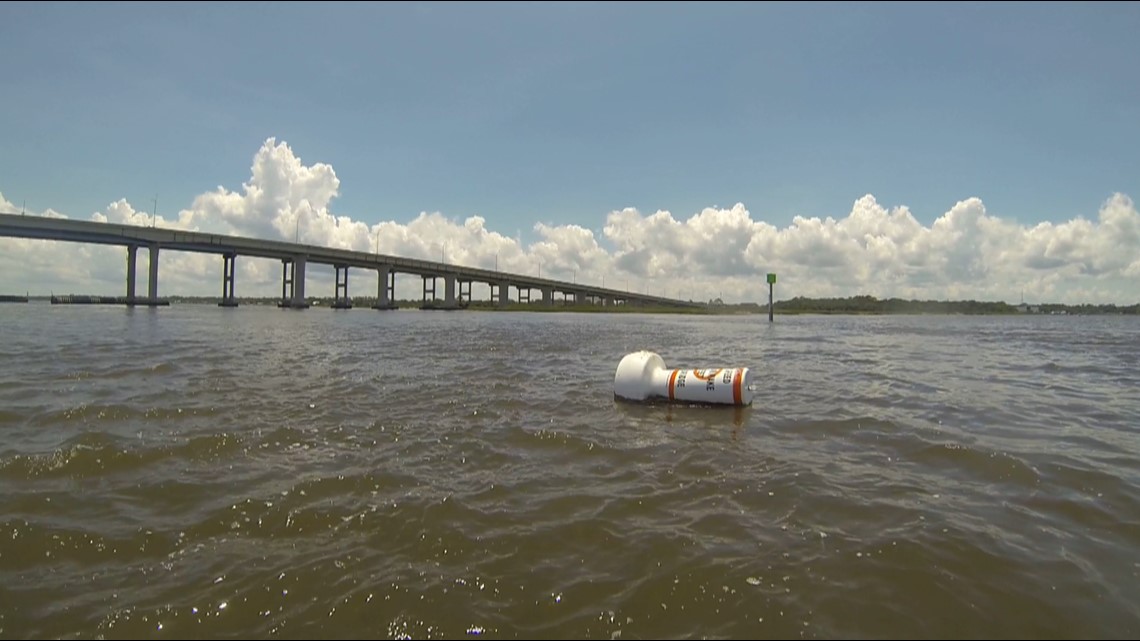ST. AUGUSTINE, Fla. - Ignorance of the law is no excuse, including in speed zones both on the road and on the water.
But obedience is a challenge when the signs are practically invisible.
Such is the case on the Intracoastal Waterway in St. Augustine, where buoys indicating 'No Wake Zones' near the Vilano Bridge, the 312 Bridge, and the Bridge of Lions are lying flat in the water instead of upright as intended. The lazing buoys - essentially speed limit markers for boaters in close proximity to bridges - are for all practical purposes illegible in an area where mariners often flout the law.


"I'd say maybe one out of ten," said Black Raven Pirate Ship tour guide Ohly Mackerel, pegging the number of boaters who drive through the slow zones fast enough to leave a wake.
Ohly - not his real name but a playful twist on the phrase, "Holy Mackerel," which he uses while entertaining ship guests - says that although his job includes plenty of staged humor, any form of boating entails real danger. He spoke with First Coast News from aboard the Black Raven while docked within the Bridge of Lions' no-wake zone and barely a hundred feet from the span's draw deck. He's seen a lot in his ten years at the helm.
"You don't have to hit somebody to interfere with them," he said, noting that a wake can cause as much damage as a collision.
"When [the buoys] first came in there, everything was fine," Ohly said, "but very shortly after, they laid over and have been sitting on their side."
The Florida Fish and Wildlife Conservation Commission (FWC), which says the buoys were installed to replace markers damaged or destroyed by Hurricane Irma in September 2017, blames the problem on the contractor it hired to install them in spring 2018.
"The buoys were not of the right type and the anchoring system was also of the wrong type," FWC lieutenant Steve Zukowsky told First Coast News, saying the new buoys in the ICW are designed for the calm waters of a lake or gentle river.
"We have currents sometimes that are six knots, incoming tide, outgoing tide," Zukowsky said.
Jaye Lunsford, who lives aboard a boat with her husband Dan, said she's only had a few items aboard broken by the jostling of wake-produced waves ... so far.
"You'll see somebody come past, just clearly operating at full speed right up to the last moment," she described a typical boater's approach to the bridges. "And then about five to seven minutes after they go through here, all the boats in here - you can see the wave coming in and you can see all the boats start rocking."
FWC told First Coast News that, sign or no sign, it is illegal to create a wake near a bridge. Statute 327.46 generally pegs that distance as within 300 feet but there are variables outlined within it. The agency said the fine for speeding in a no-wake zone is typically $50 plus court costs.
Zukowsky pointed out that the toppled buoys aren't specifically the source of the excessive speed problem.
"A lot of people ignore them even when they are upright," he cautioned.
Both Jaye Lunsford and Ohly Mackerel - who live and make a living, respectively, on the water - admit that boaters have been speeding in no-wake zones much longer than just the recent months that the buoys have been toppled. But they believe the languishing markers make the problem worse.
"[Boaters] are going to see [the buoys] as trash or whatever, and they are not going to know that that means slow down," Mackerel said.
FWC told First Coast News it hopes to have proper replacements installed by September. Right now, the agency said, taxpayers are on the hook for the nearly $15 thousand it paid for the improper buoys, but it is trying to recoup that money. With boating season in full swing, Mackerel is at least hopeful that visible warning signs will remove that thinnest of excuses: ignorance.
"Whenever you see something, you at least have to slow down to read it," Mackerel reasoned.
Lunsford agreed.
"That excuse will be taken away, and I think that will be a good thing."

